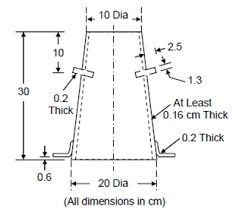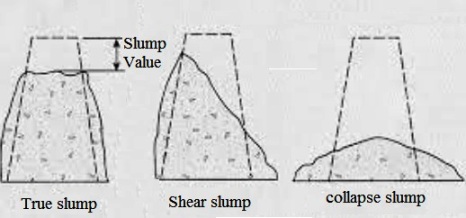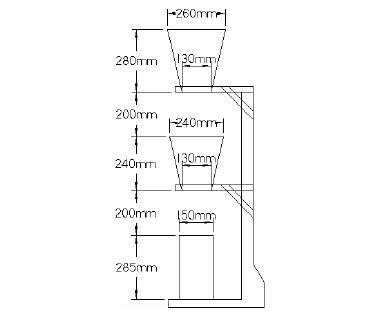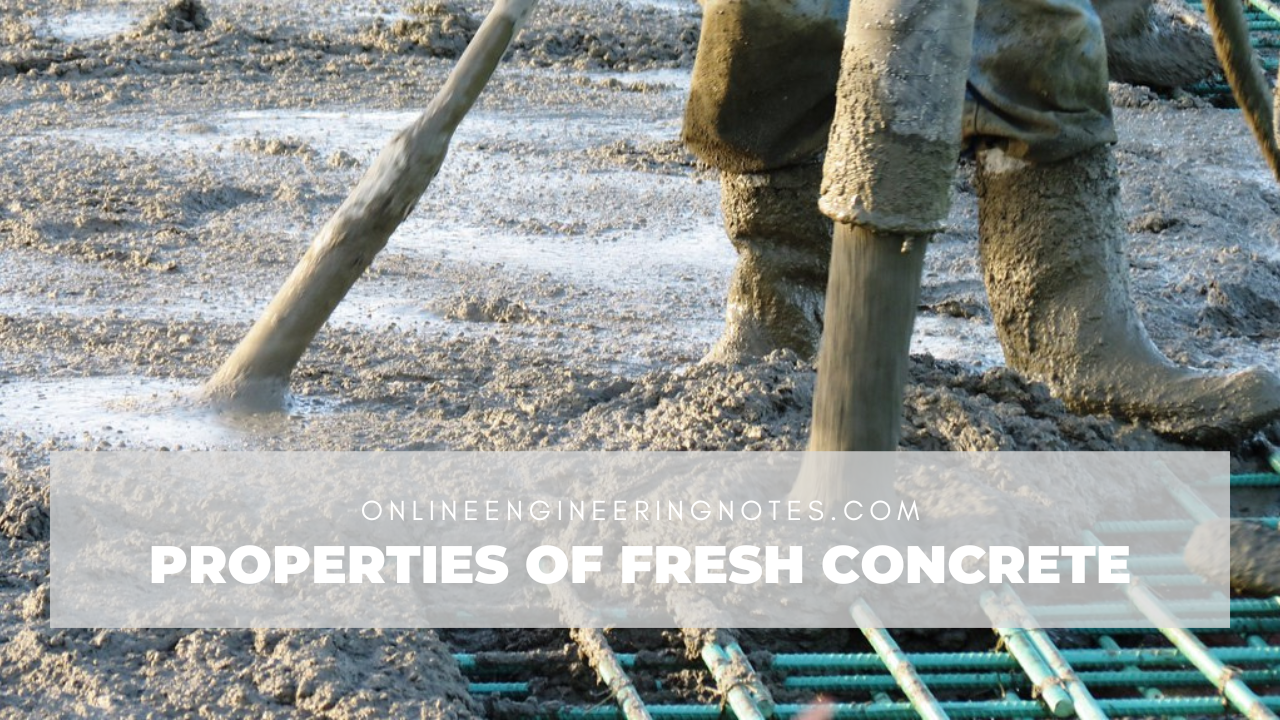1.1 Hydration of cement
- Reaction of cement with water.
- When cement comes in contact with water chemical reaction occur which results in formation of new compound which is responsible for gain of strength and hardening of cement concrete.
1.2 W/C ratio

- Amount of water required is directly related to amount of cement used in concrete.
- W/C ratio is the ratio of amount of water to amount of cement.
- Important for hydration and quality of cement.
- More w/c ratio more cement hydrated, more is the compactness of paste and more is strength. But, too much water results in unoccupied void with low strength.
- w/c ratio = (0.45 – 0.6)
1.3 Process of manufacture of cement
1. Mixing:
- Important for uniform and homogeneous concrete.
- Method of mixing are:
a. Hand mixing:
- Mixing is done with the help of tool but with power of hand of worker.
- Suitable for small work.
- Addition 10% cement is required to compensate loss of strength than machine mixing.
b. Machine mixing:
- Power of machine is used mixing concrete.
- Economical for large work.
- Suitable for medium to large work.
- Gives more homogenous and uniform mix at low w/c.
2. Handling:
- After mixing, concrete should transported at the site immediately without drying and should remain in cohesion form.
- For conveying concrete from mixer to site following method are used:
i. Pan method
ii. Wheel barrow
iii. Bucket
iv. Conveyor belt
v. Truck or lorries
3. Placing:
- After handling or transportation the concrete shall be placed to right shape and size.
- Depending upon the site different thing are to be considered during placing:
a. For foundation
- Vegetation or organic matter are removed.
- Loose earth should be removed or compacted.
b. For slab:
- Concrete should be dumped not dragged.
- During compaction of layered concrete, vibrator needle shall be penetrant to pervious layer.
c. For RCC:
- Mould releasing agent shall be applied on surface of formwork.
d. For column:
- Special formwork with opening on one side at different height shall be used.
4. Compaction:
- Concrete should be compacted after placing.
- Main objective is to remove air voids which might trapped during mixing, handling or placing of concrete.
- Method of compaction:
a. Hand compaction:
- Done for concrete of up to 15 – 20 cm layer.
- Concrete of high consistency is required for hand compaction.
- It can be done in three ways:
i. Rodding
ii. Ramming
iii. Tamping
b. Compaction by vibration:
- Suitable in general purpose concreting.
- It can compact concrete of even lower w/c ratio.
- Types of vibrator:
i. Needle vibrator
ii. Table vibrator
iii. Formwork vibrator
iv. Surface vibrator
5. Curing:
- Providing favorable environment for concrete to gain strength is desired time without harmful change.
- Strength of concrete is achieved by hydration of cement.
- Curing is done to keep the concrete moist and warm enough so that the hydration of cement continuous at optimum level for best gain of strength.
1.4 Workability and its test
- The amount of mechanical energy or work required to fully compact concrete without segregation.
- Increasing water content increases workability.
Factors affecting workability:
- Water content
- Size of aggregate
- Shape of aggregate
- Use of admixture
- Time and temperature
Workability test:
1. Slump test:
- Most common and widely used method.
- Not suitable for very dry or very wet condition.
- Measures the consistency property of concrete.
Apparatus:
- Metallic mould in shape of truncated circular pyramid with top diameter 10 cm and bottom diameter 20 cm. Height of mould of 30 cm.
Procedure:

- The base is placed on a smooth surface and the container is filled is 3-4 layer. Each layer is tamped 25 times with help of tamping rod. ( 16 mm diameter and 60 cm long rod)
- After tamping the top layer the top surface is made smooth by troweling.
- Then, The cone is lifted slowly in vertical direction and the unsupported concrete will now subside.
- The new height is measured and the height of subsidence is calculated.
- The subsidence height in mm is taken as slump loss or slump value.
- Different shape of slump are:

a. True slump:
- Reduction in height of mass without any breaking up.
b. Shear slump:
- Indicates lack of cohesion.
- Indicates not suitable for placing.
c. Collapse slump:
- Indicates w/c ratio is high i.e. concrete is too wet.
2. Compaction factor test:
- More precise and sensitive than slump test.
- Useful for concrete mix of very low workability.
- It is performed to measure the level of compaction in concrete on application of fixed amount of energy for compaction by free fall.
Apparatus:
| Mould | Diameter | Height |
| Upper hopper | 250 mm | 275 mm |
| Lower hopper | 125 mm | 275 mm |
| Cylinder | 150 mm | 300 mm |
Procedure:

- Fill the first mould without compaction and closing the bottom door.
- Open the bottom door to make the concrete free fall and collect on the second mould.
- Again, open the bottom of second mould allow free fall of concrete and collect on cylinder.
- Cut the extra concrete in the cylinder to level.
- Determine the weight of partially compacted concrete due to free fall.
- Remove the concrete from cylinder and refill the cylinder in 5 cm layer each layer being compacted with tamping rod or by vibrator.
- Then compaction factor is calculated as:
CF = Weight of partially compacted concrete / Weight of fully compacted concrete
3. Flow test:
- Method to determine workability of concrete in which concrete is allowed to flow or spread by subjecting to jolting.
Apparatus:
- Mould in shape of frustusm of cone with top diameter 17 cm and bottom 25 cm.
Procedure:

- Put the concrete in the cone in two layer each layer tamped 10 times by tamping rod.
- The cone is lifted, allowing the concrete to flow.
- The flow table is then lifted up about 4 cm and then dropped 15 times in 15 second.
- After this the diameter of concrete is measured.
- The flow is determined as:
Flow% = [Diameter of flow (cm) – 25] * 100 /25
1.5 Segregation and bleeding:
Segregation:
- Separation of the components of fresh concrete, resulting in non – uniform mix.
Segregation can be categorized into three types:
- Coarse aggregate separating out from rest of the concrete.
- Paste separating out from coarse aggregate.
- Water separating out from rest of the concrete.
Cause:
- Insufficient mixing.
- Excess water.
- Primary cause of segregation is difference is specific gravity and size of constituents of concrete.
Factors affecting segregation:
- High quantity of large size particle and gap grading.
- Low cement content.
- Too dry or too wet concrete.
Effect:
- Decrease strength of concrete.
- Doesn’t provide homogenous mass throughout the concrete.
Prevention:
- The concrete should be placed as soon as possible.
- When transporting the mix, loading should be done carefully.
- Correctly proportioning the mix.
- Use of certain workability agent.
Bleeding:
- Particular form of segregation in which the appearance of water on the surface of concrete after consolidating the concrete.
- Happens due to excessive quantity of water mix or excessive compaction.
Cause of bleeding:
- Lack of finesse.
- Too much water content in mix.
- Too much finishing.
- High temperature.
Effects of bleeding:
- Loss in homogeneity.
- Reduce bond between the aggregate and cement paste and hence reduce strength of concrete.
Prevention of bleeding:
- Addition of pozzolana.
- Increase the finess of cement.
- Use of air entrainment.
- Decrease the w/c ratio.
1.6 Concrete in extreme temperature:
- In places which experience extreme weather condition different problems are encountered in preparation, placing and curing of concrete.
1. Hot weather concreting:
- Operation of concreting done at temperature above 40oC.
Effect:
- High temperature of fresh concrete results in a more rapid hydration and leads to accelerated setting.
- Reduce the handling time of concrete.
- Difficulty in air – entrainment and curing.
- Rapid evaporation and loss of water.
Precaution of hot weathering:
- Use of retarding admixture.
- Use of cold water.
- Use of low heat cement.
- Curing of concrete should be cured with cold water.
- Covering the concrete with moist material.
2. Cold weathering concreting:
- Concreting operation done at temperature below 5oC.
Effects:
- Rate of hydration decrease with decrease in temperature.
- Delay in removal of formwork.
- Ordinary method of curing becomes difficult.
- During transportation concrete becomes hard due to ice formation.
Precaution of cold weathering:
- Concrete work should be done on day time.
- Warm water should be added for mixing of ingredients of concrete.
- Use of accelerating admixture.
- Use of high heat cement and RHC.
- Protective cover should be used for concrete.
1.7 Quality control of site:
- Quality control of site objective is to reduce the different variation and carry out the process mixing, handling, compacting and curing with utmost care so that a concrete of high workability, strength and durability is obtained.
Advantage:
- Reduce maintenance cost.
- Minimize the risk of over estimation of budget.
- Helps to obtain desired characteristics of concrete.
References:
- Dayaratnam, P. Brick and reinforced brick structure.
- Neville, A.M. Properties of Concrete. England: Pearson Education Limited.
- Hendry, A.W., Sinha, B.P. & Davies, S.R. Design of Masonry Structure. London: E & FN Spon.

